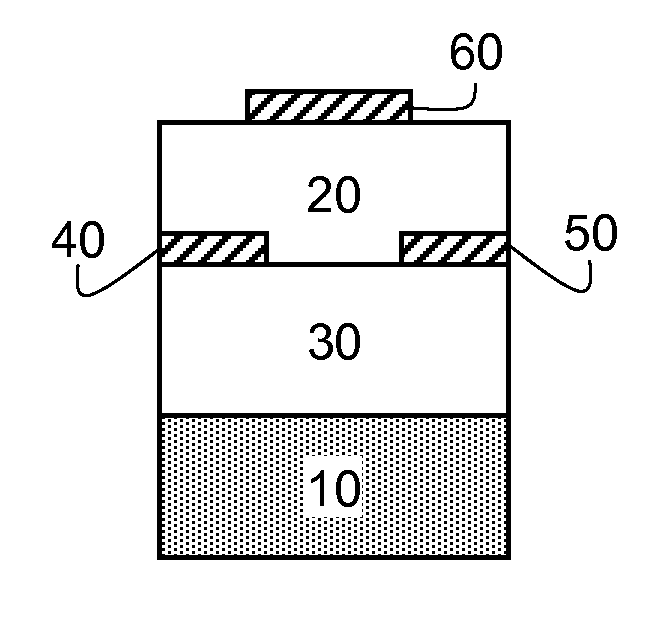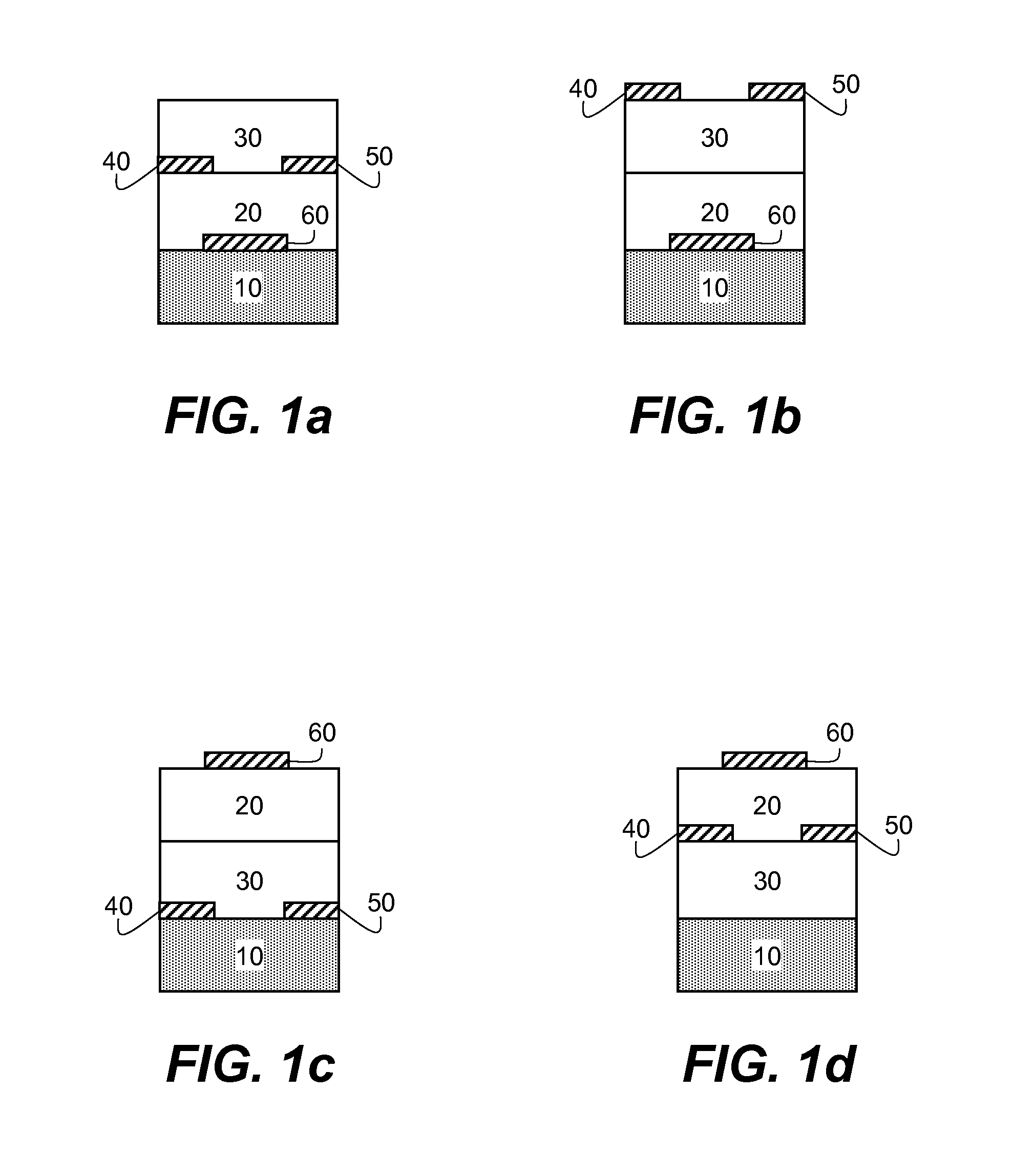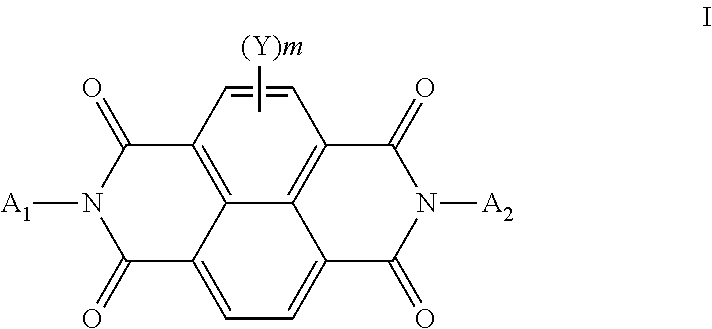Method of making n-type semiconductor devices
a semiconductor device and morphology technology, applied in semiconductor devices, naphthalimide/phthalimide dyes, electrical apparatus, etc., can solve the problems of amorphous silicon application limited to low speed devices, requires relatively costly processes, and achieves enhanced operational stability of ofet devices, better control of the morphology of semiconductor films, and the effect of enhancing the stability of the devi
- Summary
- Abstract
- Description
- Claims
- Application Information
AI Technical Summary
Benefits of technology
Problems solved by technology
Method used
Image
Examples
invention example 1
Test Device-2 (Invention Example 1)
[0193]A heavily doped silicon wafer with a thermally-grown SiO2 layer with a thickness of 195 nm was used as the substrate. The wafer was cleaned for 10 minutes in a piranha cleaning solution, followed by a 6-minute exposure in a UV / ozone chamber. An organic semiconducting formulation consisting essentially of N,N′-trans-4-pentylcyclohexyl)-1,4,5,8-naphthodiimide (Compound I-4) (0.5 weight %) and polystyrene (0.5 weight %, Aldrich Chemical Co., average Mw 200,000) in distilled 1,2,4-trimethylbenzene was coated onto silicon dioxide dielectric at 800 RPM for 30 seconds followed by 5000 RPM for 45 seconds. A sample was annealed in air at 100° C. for 1 hour. Subsequently, a gold source and drain electrodes were vapor deposited through a shadow mask to a thickness of 50 nm. The resulting devices had a 650 μm channel width, with channel lengths varying from 50 to 150 μm. Multiple OFET's were prepared and 4 to 12 representative samples were tested for eac...
invention example 2
Test Device 4 (Invention Example 2)
[0200]An organic semiconducting formulation consisting essentially of N,N′-trans-4-pentylcyclohexyl)-1,4,5,8-naphthodiimide (Compound I-4) (0.5 weight %) and polystyrene (0.5 weight %, Aldrich Chemical Co., average Mw 200,000) as the polymer additive in distilled 1,2,4-trimethylbenzene was coated onto the PMMA dielectric layer at 800 RPM for 30 seconds followed by 5000 RPM for 45 seconds. Each sample was annealed in air at 100° C. for 1 hour. Subsequently, a gold source and drain electrodes were vapor deposited through a shadow mask to a thickness of 50 nm. The resulting devices had a 650 μm channel width with channel lengths varying from 50 to 150 μm. Multiple OFET's were prepared and 4 to 12 representative samples were tested for each deposition run. The averaged results appear in TABLE II below.
[0201]The electrical parameters of the devices were measured and calculated as described for Invention Example 1. The average mobility was found to be 0....
invention example 3
Test Device 5 (Invention Example 3)
[0204]An organic semiconducting layer formulation consisting essentially of N,N′-trans-4-pentylcyclohexyl)-1,4,5,8-naphthodiimide (Compound I-4) (0.5 weight %) and Zeonex® RS420 (0.1 weight %) in distilled 1,2,4-trimethylbenzene was coated onto the PMMA dielectric layer at 800 RPM for 30 seconds followed by 5000 RPM for 45 seconds. Each sample was annealed in air at 100° C. for 1 hour. Subsequently, a gold source and drain electrodes were vapor deposited through a shadow mask to a thickness of 50 nm. The resulting devices had a 650 μm channel width with channel lengths varying from 50 to 150 μm. Multiple OFET's were prepared and 4 to 12 representative samples were tested for each deposition run. The averaged results appear in TABLE III below along with the results previously reported for Test Device 3 (Comparative Example 2).
[0205]The electrical parameters of the devices were measured and calculated as described above for Invention Example 1. The a...
PUM
 Login to View More
Login to View More Abstract
Description
Claims
Application Information
 Login to View More
Login to View More - R&D
- Intellectual Property
- Life Sciences
- Materials
- Tech Scout
- Unparalleled Data Quality
- Higher Quality Content
- 60% Fewer Hallucinations
Browse by: Latest US Patents, China's latest patents, Technical Efficacy Thesaurus, Application Domain, Technology Topic, Popular Technical Reports.
© 2025 PatSnap. All rights reserved.Legal|Privacy policy|Modern Slavery Act Transparency Statement|Sitemap|About US| Contact US: help@patsnap.com



